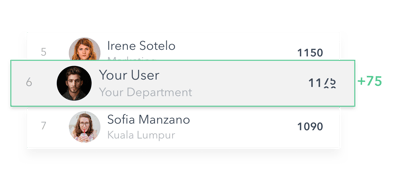Before talking about how and why you should engage and develop your employees with gamification, let’s have a quick look at what “gamification” actually is.
What is Gamification?
The common understanding and definition of gamification are to implement game design elements in a non-game context. It can, for example, be features like:
- Badges
- Points
- Rankings
- Leaderboards
A badge is a digital diploma, certificate or medal you achieve when you have passed a course and fulfilled the requirements.
 Points and rankings have many expressions depending on the context. For example, you can gain points for a finished e-learning course and then get ranked compared to your colleagues/ competitors or your own previous performances.
Points and rankings have many expressions depending on the context. For example, you can gain points for a finished e-learning course and then get ranked compared to your colleagues/ competitors or your own previous performances.
Often leaderboards are seen in sales departments where you can compare yourself with your colleagues' performance and feel motivated to do better if you aren't in the top ten. Also, you can feel acknowledged in your work if you have a high ranking.
In the video below you can see the features of our Training Pro module.
Gamification in skill training and personal development programs
Gamification includes the elements listed below when it is implied in a training context:
- Challenge and competition
- Narrative and immersion within courses
- Support and feedback via surveys
Studies underline the importance of training your managers before you roll out training to the rest of the employees in your organization. Therefore, it is important that training is designed to provide requisite social support and feedback to facilitate employee engagement.
As a result, the support and feedback of your employees will be more precise, valuable and measurable. In this way, you can increase your employees’ job satisfaction and self-efficacy when you use gamification in the proper way.

How gamification engages and develops your employees
So how does gamification affect your employees? Let’s take a look at some concrete examples:
- Badges increase self-efficacy
- Competition and challenges increase engagement
- Support and feedback create a feeling of inclusion and participation
Badges function as strong and efficient motivational factors when your employee passes a course in a training or development program. Since your employees can see their new skills, their self-efficacy reinforces. Your employees feel more confident and equipped for their job tasks ahead of them which boosts both the service level and work satisfaction.
Competitive elements like points and rankings are a way for your employees to feel acknowledged. Their hard work and effort pay off when they rank high on the leaderboards. Also, it can create a high level of team spirit if you compete in teams against other teams and not on an individual level.

Inclusion and participation are other ways to engage your employees. One of the most efficient and easiest ways is to create surveys where it is possible for your employees to give feedback on internal activities.
Why use gamification to engage your employees?
There are several reasons why you should use gamified learning programs and training in your organization as a part of employee engagement.
A study shows that gamified learning:
- Increases learning engagement
- Increases attendance and participation
- Decreases the gap between high- and low-learners
The researchers concluded that gamified learning is more motivating and interesting than other learning systems.
When learning, training and personal development become fun and motivating the learning outcomes are better, stronger and more efficient.
This increases your employees’ self-efficacy which affects their performance and engagement in your organization. When they gain badges as a personal achievement they feel more confident in their work and acknowledged for their effort.





